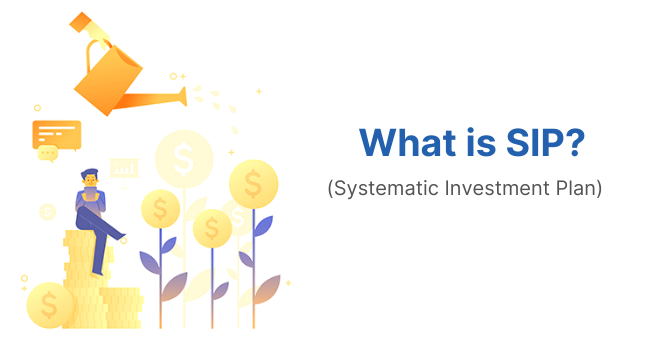The SIP stands for the Systematic Investment Plan. It is a medium to invest in the Mutual Funds Scheme. One can easily, flexibly, and smartly invest in SIP. It is one of the most popular investment plans. Through SIP one can invest at regular mode in the Mutual Funds with a determined amount at a regular interval. The pre-determined amount can be Rs. 500, Rs. 1000, and so on and one can invest at a regular interval which can be weekly, monthly, quarterly, half-yearly, or on yearly basis. The SIP also helps to build a habit of savings.
To understand the concept of SIP, let’s take an example: People can take a loan to fulfill their basic requirements. Due to the lack of money people take a loan and pay it back on the monthly EMI but, they have to pay a high-interest rate of returns whereas, in SIP, there is no need to pay any interest in the SIP. By entering into SIP, a person can easily invest in Mutual Funds and can create wealth over the long run. Here, SIP amounts get automatically deducted from your bank account.

How does the SIP works?
The SIP works on the principle of “few drops of water can slowly fill up the empty container”. The SIP chooses a flexible pre-determined amount and interval which is auto-debited from your account and invested in specific Mutual Funds schemes. The Mutual Funds invest your money at a certain number of units allocated and hence, you will be benefited from Rupee-Cost Averaging & Power of Compounding.
Here the question arises, that how the units allotted to us?
Let’s assume that a Mutual Fund scheme has NAV 20 rupees at a particular period and there you have invested Rs. 1000 in it. Therefore, one will be allotted by
50 units => 1000/20 = 50 units.
If the NAV of mutual funds increases then, the money you invested will also increase. For Example, if the NAV will increase up to 30 rupees, your investment value will also increase to 1,500 rupees.
- 50 (units) × INR 30 (NAV) = INR 1,500 (Investment value)
Therefore, your money can grow by investing in SIP and create wealth.
The Investment is consistent irrespective of the concepts of the market. When the market is low, one will gain more stocks and when the market is high, the stocks will become limited. Over some time, the cost of stocks will average out and one will receive a handsome profit despite the volatile market.
Features of SIP
The key features of SIP are listed below:
- The SIP investment is always done in open-ended funds. One can exit from these investments very easily at any time.
- There is no fixed tenure in SIP.
- There is perpetual SIP, one can invest the SIP in the short-term as well as for the long-term as per their choice.
- One can fully or partially withdrawal its amount after the maturity period of the SIP.
- SIP amount can be decreased or increased anytime according to one’s choice. For example: If one is having Rs. 1000 investment in SIP, then he/she can reduce its amount to INR 5,000 or also increase it up to INR 15,000 for the rest of the months of till the maturity period.
Therefore, due to the above-mentioned features and flexibility of the SIP investment, it is an ideal investment plan for those investors who are dependent on the regular monthly income.
Benefits of SIP
The main benefits of investing in SIP are as follows:
- The SIP helps to manage market volatility.
- It also helps in making your financial decision in the discipline.
- There are no charges applicable to invest in SIP.
- It also provides compound interest benefits to its investors.
- The investment in SIP starts from the lowest amount of Rs.500 and can increase his investment during the tenure.
Why should I invest in SIP?
One should invest in SIP because the Rupee cost can be average out as it works on the principle of market value and provides better returns. It also provides the Power of Compounding. Power of Compounding is the returns generated not only on investing but, the returns generated on profits also. For example, A person invested the amount of Rs.10,000 in the Mutual Funds scheme, and the returns provided on it is 15% therefore, the amount generated after 1 year is Rs. 1,15,000. But here, In the Power of Compounding, the annual returns on the Rs. 1,15,000 will generate more income and returns from the second year of a person’s investment. One should invest in a disciplined way according to the person’s capacity, savings, expenditure, etc.
Types of SIP
There are 4 types of SIP introduced by Fund Houses that suit different types of investors. The types of SIP are explained below:
- Flexible SIP: The flexible SIP allows a person to adjust the amount of SIP-based on the market and his financial conditions. The market conditions are a pre-decided formula, which enables the investor to invest low when the market is high and invest high when the market is falling. While on the other hand, the financial conditions are also working similarly as one can increase or reduce the SIP amount according to his financial condition. Therefore, an investor always has the option to choose the amount as required in flexible SIP.
- Step-up SIP: This is one of the most preferred by SIP investors because of its special feature which allows its investors to increase the SIP amount at fixed intervals. For Example, If someone has started investing with Rs.10,000 and instructed the fund house to increase the SIP amount by Rs.1000 at every 6-month interval, the SIP investing amount will be Rs.11,000 after the first 6 months and the same process will be continued.
- Trigger SIP: In trigger SIP, one can set the trigger for its investment by mentioning the SIP amount withdrawal from his/her bank account. The trigger option allows you to select the specific dates and index level but make sure that one must be an experienced investor and has sufficient knowledge to set such effective triggers.
- Perpetual SIP: This kind of SIP is worth special attention. While Starting a SIP, you need to fill in the start and end date of your investment but usually, investors only mention the starting date. In this case, the SIP will run until 2099 and you need to send an application to the fund house whenever you want to stop the SIP. It is better to mention the end date if you wish to invest in a fixed tenure.
SIP Tax Benefits
By initiating SIP into the ELSS Mutual Funds, you can earn the tax deduction benefits under Section 80C of the Income Tax Act, 1961. Under this Act, a person can claim a Tax Rebate of up to Rs.1.5 lac and can save a lot of money during a year. As the ELSS Funds are equity-oriented funds with the portfolio invested with at least 65% equity, ELSS funds can provide high returns with tax deduction benefits. With the SIP, the taxpayers don’t invest the amount in lump-sum but they invest a smaller amount each month and by the end of the following year, one can be able to claim the tax deduction.
SIP Calculator
The SIP Calculator works as a tool to calculate the mutual fund’s investment returns through SIP. The SIP Calculator calculates the expected returns and the wealth gain for the monthly SIP investment. Perhaps, one can get a rough idea as it is based on the projected annual return rate.
How to calculate returns using SIP Calculator?
You can calculate the interest in SIP Calculator based on the formula given below:
M = × ({[1+i] n-1) × (1×i)
Here, M = the amount you will receive on its maturity.
P = the amount you invest at a regular interval of time.
N = Number of the payments, you will make.
I = Periodic rate of interest.
Now, to calculate the interest you should enter the monthly investment amount on the calculator then, put the number of years in which you want to be in the SIP investment also enter the expected rate of returns. Once you input the following value on the SIP Calculator, within seconds the calculator will show the estimated amount value you can avail after its maturity period.
Frequently Asked Questions
Q1. How do I start investing in SIP?
Ans. A person can easily and conveniently apply for the SIP without any paperwork or any long process by “ET Money” application. One can start investing in SIP through ET Money with some simple steps which are explained below:
- Visit the ET Money application.
- Click on the option of Direct Mutual Fund’s homepage.
- There you will find another option of Start a SIP.
- Then you have to find your suitable SIP investment plans according to your criteria depends on your risk tolerance and tenure.
- And hence, the SIP will start easily within 5 minutes without any paperwork and also has the feature of tracking your investment amount through the ET Money App.
Q2. How much amount a person can invest in SIP?
Ans. The starting or minimum amount a person can invest with SIP is Rs.500 per month and for the maximum, there is no limit of SIP investment. One can invest up to any amount.
Q3. Are the Mutual Funds similar to SIP or different from one another?
Ans. The SIP is not a stock or investment, funds or scheme. It is just an investment style. It is an investment vehicle to enter into any fund or scheme by which one can invest periodically.
Q4. Is it possible for a person to renew his SIP?
Ans. Yes, one can renew his SIP automatically through the company they invested in. The company also provides the option to cancel the auto-renew feature whenever an investor wishes to exit from it.
Q5. How can one modify or check the SIP amount?
Ans. A person can check its return by the SIP Investment Calculator anytime and can also increase or decrease the amount.
